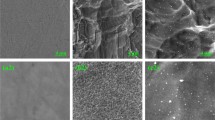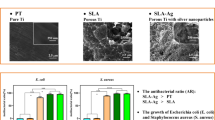Abstract
Novel researches are focused on the prevention and management of post-operative infections. To avoid this common complication of implant surgery, it is preferable to use new biomaterials with antibacterial properties. Therefore, the aim of this work is to develop a method of combining the antibacterial properties of antibiotic-loaded poly(3-hydroxybutyrate) (PHB) nano- and micro-spheres and poly(ethylene glycol) (PEG) as an antifouling agent, with titanium (Ti), as the base material for implants, in order to obtain surfaces with antibacterial activity. The Ti surfaces were linked to both PHB particles and PEG by a covalent bond. This attachment was carried out by firstly activating the surfaces with either Oxygen plasma or Sodium hydroxide. Further functionalization of the activated surfaces with different alkoxysilanes allows the reaction with PHB particles and PEG. The study confirms that the Ti surfaces achieved the antibacterial properties by combining the antibiotic-loaded PHB spheres, and PEG as an antifouling agent.










Similar content being viewed by others
Reference
Greenberg EP, Costerton JW. Stewart PS, Bacterial biofilms: a common cause of persistent infections. Science. 1999;5418:1318–22.
Darouiche RO. Treatment of infections associated with surgical implants. N Engl Jed. 2004;350:1422–9.
Francolini I, Donelli G. Prevention and control of biofilm-based medical-device-related infections. FEMS Immunol Med Mic. 2010;59:227–38.
Harris LG, Richards RG. Staphylococci and implant surfaces: a review. Injury. 2006;37(2):3–14.
Dunne WM. Bacterial adhesion: seen any good biofilmslately? Clin Microbiol Rev. 2002;15:155–66.
Koller M, Bona R, Braunegg G, Hermann C, Horvat P, Kroutil M, Martinz J, Neto J, Pereira L, Varila P. Production of polyhydroxyalkanoates from agricultural waste and surplus materials. Biomacromol. 2005;6(2):561–5.
TianP-Y, Shang L, Ren H, Mi Y, Fan D-D, Jiang M. Biosynthesis of polyhydroxyalkanoates: Current. Afr J Biotechnol. 2009;180:709–714.
Khosravi-Darani K, Bucci DZ. Application of poly(hydroxyalkanoate) in food packaging: improvements by nanotechnology chem. Biochem Eng Q. 2015;29(2):275–85.
Korsatko VW, Wabnegg B, Tillian HM, Egger G, Pfragner R, Walser V. Poly-D-(-)-3-hydroxybutyric acid (poly-HBA) a biodegradable polymer for long term medication dosage. 3. Studies on biocompatibility opoly-HBA implantation tablets in tissue culture and animals. Pharm Ind. 1984;46:952.
Williamson DH, Mellanby J, Krebs HA. Enzymic determination of D(-)-β-hydroxybutyric acid acetoacetic acid in blood. Biochem J. 1961;82(1):90–6.
Wang Y-W, Yang F, Wu Q, Cheng I-C, Yu PHF, Chen J, Chen G-Q. Effect of composition of poly(3-hydroxybutyrate-co-3-hydroxyhexanoate) on growth of fibroblast and osteoblast. Biomat. 2005;26:755–761.
Huag H-S, Chou S-H, Dona T-M, Lai W-C. Formation of microporous poly(hydroxybutyric acid) membranes for culture of osteoblast and fibroblast. Polym Adv Technol. 2009;20:1082–1090.
Rodríguez-Contreras AM, Canal-Barnils C, Calafell-Monfort M, Ginebra-Molins M-P, Julio-Morán G, Marqués-Calvo MS. Methods for the preparation of doxycycline-loaded phb micro- and nano-spheres. European Pol J. 2013;49:3501–3511.
Chen G-Q. Plastics Completely Synthesized by Bacteria: Polyhydroxyalkanoates. Plastics from Bacteria: Natural Functions and Applications. New York: 2010;6:17–37.
Alcantar NA, Aydil ES, Israelachvili JN. Polyethylene glycol-coated biocompatible surfaces. J Biomed Mat Res. 2000;51(3):343–51.
Mondal M, De S. Characterization and antifouling properties of polyethylene glycol doped PAN–CAP blend membrane. RSC Adv. 2015;5:38948–63.
Dalsin JL, Messersmith PB. Bioinspired antifouling polymers. Mater Today 2005; 38–46.
Jeon SI, Andrade JD. Protein-surface interactions in the presence of polyethylene oxide: II effect of protein size. Colloid Interf Sci. 1991;142:159–66.
Gref R, Lück M, Quelle P, Marchan M, Dellacheri E, Harnisch S, Blunke T, Müller RH. ‘Stealth’ corona-core nanoparticles surface modified by polyethylene glycol (PEG): influences of the corona (PEG chain length and surface density) and of the core composition on phagocytic uptake and plasma protein adsorption. Colloids Surf B: Biointerfaces. 2000;18:301–13.
Banerjee I, Pangule RC, Kane RS. Antifouling coatings: recent developments in the design of surfaces that prevent fouling by proteins, bacteria, and marine organisms. Adv Mate. 2011;23:690–718.
P. Sevilla-Sánchez, Functionalization of titanium surfaces with TGF-beta inhibitor peptides. PhD thesis. Universitat Politècnica de Catalunya-Barcelona TECH, Barcelona, Spain, (2013).
Rodríguez-Hernández MJ, Cuberos L, Pichardo C, Caballero FJ, Moreno I, Jiménez-Mejías ME, García-Curiel A, Pachón J. Sulbactam efficacy in experimental models caused by susceptible and intermediate Acinetobacter baumannii strains. J Antimicrobial Chemotherapy. 2011;47(4):479–82.
Balwanz WW. Plasma Cleaning of Surfaces. Surface Contamination Genesis, Detection, and Control, New York; 1979; 255–269.
Paredes V, Salvagni E, Rodriguez E, Gil J, Manero JM. Assessment and comparison of surface chemical composition and oxide layer modification upon two different activation methods on a cocrmo alloy. J Mat Sci Mater Med. 2013;25(2):311–20.
Kim HM, Miyaji F, Kokubo T, Nakamura T. Preparation of bioactive Ti and its alloys via simple chemical surface treatment. J Biomed Materm Res. 1996;32:409–17.
Wang XX, Hayakawa S, Tsuru K, Osaka A, Improvement of the bioactivity of H2O2/TaCl5-treated Ti after a subsequent heat treatment. J Biomed Mater Res 2000; 171–176.
Pattanayak DK, Yamaguchi S, Matsushita T, Kokubo T. Nanostructured positively charged bioactive TiO2 layer formed on Ti metal by NaOH, acid and heat treatment. J Mater Sci Mater in Medicine. 2011;22:1803–12.
Lindahl C, Engqvist H, Xia W. Influence on surface treatments on the bioactivity of Ti. ISRN Biomat 2013; 1–13.
Li D, Teoh WY, Gooding JJ, Selomulya C, Amal R. Functionalization strategies for protease immobilization on magnetic nanoparticles. Adv Funct Mater. 2010;20(11):1767–77.
Chan R, Marcal H, Russell RA, Holden PJ, Foster LJ. Application of polyethylene glycol to promote cellular biocompatibility of polyhydroxybutyrate films. Int J Pol Sci 2011;1–9.
Sevilla P, Godoy M, Salvagni E, Rodriguez D, Gil FJ. Biofunctionalization of titanium surfaces for osseintegration process improvement. J. Physics Conf Series. 2010;252:012009.
Wang Y-Y, Liu LX, Shi JC, Wang H-F, Xiao Z-D, Huang N-P. Introducing RGD peptides on PHBV Films through PEG-containing cross-linkers to improve the biocompatibility. Biomacromol. 2011;12:551–9.
Gharechahi M, Moosavi H, Forghani M. Effect of surface roughness and materials composition on biofilm formation. J Biomat Nanobiotech. 2012;3:541–6.
Acres RG, Ellis AV, Alvino J, Lenahan CE, Khodakov DA. Molecular structure of 3-aminopropyltriethoxysilane layers formed on silanol-terminated silicon surfaces. J Phys Chem C. 2012;116(10):6289–97.
Nalawade TM, Bhat K, Sogi SHP. Bactericidal activity of propylene glycol, glycerine, polyethylene glycol 400, and polyethylene glycol 1000 against selected microorganisms. J Int Soc Prev Commun Dent. 2015;5(2):114–9.
Bonartsev A, Yakovlev S, Boskhomdzhiev A, Zharkova I, Bagrov D, Myshkina V, Mahina T, Kharitonova E, Samsonova O, Zernov A, Zhuikov V, Efremov Y, Voinova V, Bonartseva G, Shaitan K. The terpolymer produced by azotobacter chroococcum 7B: effect of surface properties on cell attachment. PLoS One. 2013;8(2):e57200.
Bonartsev AP, Yakovlev SG, Zharkova II, Boskhomdzhiev AP, Bagrov DV, Myshkina VL, Makhina TK, Kharitonova EP, Samsonova OV, Feofanov AV, Voinova VV, Zernov AL, Efremov YM, Bonartseva GA, Shaitan KV, Kirpichnikov MP. Cell attachment on poly(3-hydroxybutyrate)-poly(ethylene glycol) copolymer produced by Azotobacter chroococcum 7B. BMC Biochem. 2013;14:1–12.
Truica-Marasescu F, Wertheimer M. Nitrogen rich plasma polymer films for biomedical applications plasma processes pol. 2008;5:44–57.
Chaudhary SB, Vives MJ, Basra SK, Reiter MF. Postoperative spinal wound infections and postprocedural diskitis. J Spinal Cord Med. 2007;30(5):441–51.
Herranz-Diez C, Lib Q, Lamprecht C, Mas-Moruno C, Neubauerd S, Kessler H, Manero JM, Guillem-Marti J, Selhuber-Unkel C. Bioactive compounds immobilized on Ti and TiNbHf: aFM-basedinvestigations of biofunctionalization efficiency and cell adhesion. Col Surf B: Biointerf. 2015;136:704–11.
Paredes V, Salvagni E, Rodríguez-Castellón E, Gil FJ, Manero JM. Study on the use of 3-aminopropyltriethoxysilane and 3-chloropropyltriethoxysilane to surface biochemical modification of a novel low elastic modulus Ti–Nb–Hf alloy. J Biomed Mater Res Part B. 2015;103B:495–502.
Fernandes JG, Correia DM, Botelhon G, Padrão J, Dourado F, Ribeiro C, Lanceros-Méndez S, Sencadas V. PHB-PEO electrospun fiber membranes containing chlorhexidine for drug delivery applications. Pol Testing. 2014;34:64–71.
Shrivastav A, Kim H-Y, Kim Y-R. Advances in the Applications of Polyhydroxyalkanoate Nanoparticles for Novel Drug Delivery System. BioMed Research Int 2013;12.
Wang Y-W, Wu Q, Chen G-Q. Attachment, proliferation and differentiation of osteoblasts on random biopolyester poly(3-hydroxybutyrate-co-3-hydroxyhexanoate) scaffolds. Biomat. 2004;25:669–75.
Chen C, Cheng YC, Yu CH, Chan SW, Cheung MK, Yu PH. In vitro cytotoxicity, hemolysis assay, and biodegradation behavior of biodegradable poly(3-hydroxybutyrate)-poly(ethylene glycol)-poly(3-hydroxybutyrate) nanoparticles as potential drug carriers. J Biomed Mater Res Part A. 2008;87(2):290–8.
Acknowledgments
This study was supported by the Ministry of Economy and Competitiveness (MINECO) of the Spanish Government (Project: MAT2012-30706).
Author information
Authors and Affiliations
Corresponding author
Rights and permissions
About this article
Cite this article
Rodríguez-Contreras, A., Marqués-Calvo, M.S., Gil, F.J. et al. Modification of titanium surfaces by adding antibiotic-loaded PHB spheres and PEG for biomedical applications. J Mater Sci: Mater Med 27, 124 (2016). https://doi.org/10.1007/s10856-016-5723-4
Received:
Accepted:
Published:
DOI: https://doi.org/10.1007/s10856-016-5723-4




